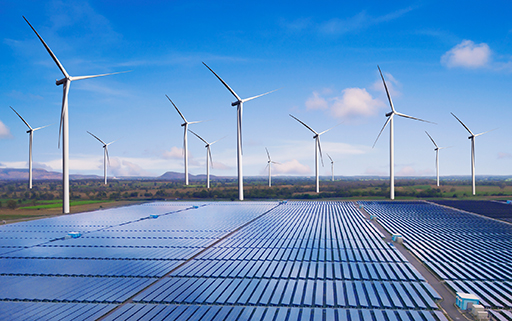Aviation Industry Embraces Renewable Energy to Combat Climate Change

By Yemi Olakitan
Several prominent airlines have undertaken ambitious commitments to reduce their carbon emissions and embrace renewable energy sources, marking a transformative shift in the aviation industry.
Air France-KLM has set its sights on a 40% reduction in carbon emissions by 2030, backed by significant investments in renewable energy projects, such as the construction of wind farms and solar facilities.
Delta Airlines, mirroring this commitment, aims to slash carbon emissions by 50% by 2050 and has ventured into initiatives like on-site solar arrays to harness the power of renewable energy.
The aviation sector, recognizing the potential of renewable energy, is poised to make substantial strides in reducing its carbon footprint. Compared to traditional fossil fuels, renewable sources like solar and wind produce minimal to no carbon dioxide emissions.
Furthermore, the declining costs of renewable energy make it an increasingly attractive option for airlines.
The adoption of renewable energy in aviation extends beyond environmental benefits. It has the potential to bolster employment opportunities and stimulate economic growth. Renewable energy projects often create jobs and attract investments, fostering regional economic development.
This transition towards renewable energy sources in aviation is not a mere trend but a significant step toward a greener and more sustainable future. Airlines can contribute to emissions reduction while simultaneously generating jobs and business opportunities by supporting renewable energy initiatives.
One of the promising innovations in this shift is the exploration of renewable energy sources to power aircraft propulsion systems. Solar and electric power, as alternatives to conventional fossil fuel-based methods, offer higher efficiency and reduced carbon emissions.
Electric aircraft propulsion systems are not only environmentally friendly but also lighter, enhancing performance and extending range.
Safety is another paramount advantage of renewable energy sources, with electric power being more stable and less prone to environmental damage, reducing the risk of spills and burns associated with traditional fuel tanks.
Moreover, the adoption of renewable energy can translate into cost savings for the aviation industry. Aircraft powered by electricity and solar energy demand less maintenance compared to their fossil fuel counterparts. The decreasing costs of solar energy and electricity further contribute to cost-effective aviation.
Renewable energy sources are gaining traction due to their increasing availability and affordability, offering a viable alternative to conventional fuel-based systems. This transition holds the potential to reduce costs, enhance safety, and curb emissions in aviation.
Recognizing the significance of this transition, a study by the International Civil Aviation Organization (ICAO) and the Netherlands Aerospace Centre (NLR) delves into the economic feasibility of shifting from conventional fuels to renewable energy sources like electricity, hydrogen, and biofuels.
The study assesses the lifecycle costs of renewable energy sources, their impact on aircraft design and operation, as well as their emissions and noise reduction potential.
The findings of this study hold promise for the aviation sector, guiding investment decisions and strategies towards the adoption of renewable energy sources. The anticipated release of the study’s results in early 2020 will shed light on the potential of renewable energy in aviation and its financial implications.
Nevertheless, the aviation sector faces significant challenges in transitioning from fossil fuels to renewable energy sources.
This shift necessitates a comprehensive overhaul of infrastructure, technological innovations, and regulatory reforms.
Currently, the industry relies heavily on fossil fuels, but mounting pressure to reduce emissions is driving the adoption of renewable alternatives.
Overcoming technological barriers and regulatory obstacles remains a formidable task.
However, initiatives such as the Federal Aviation Administration’s sustainable aviation fuels program in the United States and the commitments of major airlines like British Airways to invest in carbon offsetting and renewable energy projects demonstrate progress toward a greener aviation industry.
Biofuels, hydrogen, and electricity are emerging as promising alternatives for powering aircraft, with biofuels already making significant inroads.
Hydrogen-powered aircraft, while in early stages of development, hold potential for quieter and more efficient flights. Electric aircraft, although nascent, could revolutionize short-haul travel with their reduced noise and emissions.
Africa, too, is making strides in embracing sustainable aviation fuel, with Kenya Airways pioneering the use of Eni Sustainable Mobility’s biojet fuel.
This milestone marks progress in decarbonizing African aviation and aligns with global regulations requiring the inclusion of sustainable aviation fuels in European airports by 2025.
In conclusion, the aviation sector’s transition to renewable energy sources is a complex journey with immense environmental and economic implications. Despite challenges, the allure of cleaner, safer, and cost-effective alternatives is driving the industry forward.
As technology advances, the aviation sector inches closer to a greener and more sustainable future, with renewable energy sources at its core.
